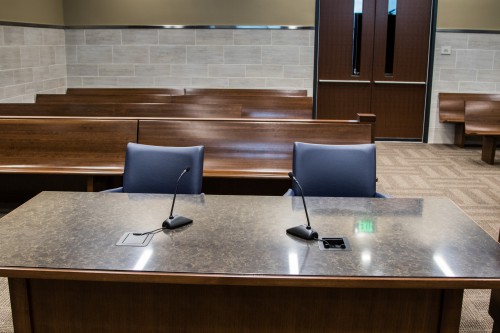 By Kendra Hall
By Kendra Hall
Last Friday, the jury began deliberation in the trial for the two co-defendants Christopher Moore and James Kenney after each attorney delivered a compelling closing statement. The defendants are accused on four counts of drug and weapons possession with enhancements including the intent to distribute for sale.
Prior to the start of their closing statements, the defense was permitted by the court to present an exhibit consisting of seven police photos to the jury. In each of these photos a new face appeared, curiously none of whom belonged to the defendants. These photos were shown to the court because they are connected to this case and correspond with a police report which according to the defense attorneys, the prosecution failed to disclose within the appropriate time limit set by the court. Although little was said to the jury at the time the photos were presented, it became apparent later that these individuals were in fact arrested at the Merkley apartment where the drugs and weapons paraphernalia (related to the charges against the defendants) were recovered. Judge Rosenberg instructed the jury to consider these photos.
Deputy District Attorney Shelby Davitt began her closing argument first. She emphasized the overarching body of evidence recovered from the three locations in this case including large quantities of heroine, methamphetamines, cocaine, guns and ammunition. She discussed activity observed while the defendants were under police surveillance, underscoring the “short stay traffic” observed at  the Merkley St. apartment, noting that the investigation began when an individual leaving the apartment was found with meth.
the Merkley St. apartment, noting that the investigation began when an individual leaving the apartment was found with meth.
She noted that Mr. Moore seemed to be the “doorman” at this apartment. On a separate occasion, Mr. Kenney was stopped after leaving this location and found to have $1,607.00 in cash on his person. She discussed a third Maple St. location at which the two defendants had been seen and where police found drug paraphernalia, and which had enhanced security features including a security camera and a “barricaded” door.
She emphasized the presence of two Michael Kors backpacks that contained some of these illicit contents; referring to them as “mobile drug selling kits.”
One backpack was found in the back of a vehicle belonging to Mr. Kenney and the other at an Evans St. address which she proposed was the place where Mr. Kenney lived with his “family”; calling it the “home base” for this alleged drug selling operation.
Additionally, she discussed a player’s card bearing the name “James K.” which the police found on top of a dresser at the Merkley St. location wherein several loose bullets were also located. She closed her statements by telling the jury that one bullet or one bag of drugs could be enough to convict. However, she emphasized that they didn’t need to lean on just one piece of evidence.
Rather, she urged the jury to consider the overarching spectrum of evidence and testimony which they have heard throughout this case, and based on that, render a guilty verdict.
Attorney Lisa Lance, representing Mr. Moore and Attorney Jeff Raven, representing Mr. Kenney reexamined and subsequently challenged the prosecution’s evidence on various fronts. Both attorneys  firstly discussed the importance and meaning of the phrase, “beyond a reasonable doubt” emphasizing the legal obligation to render a not guilty verdict if the standards for this are not met by the prosecution. Both claimed that the prosecution had failed in this task.
firstly discussed the importance and meaning of the phrase, “beyond a reasonable doubt” emphasizing the legal obligation to render a not guilty verdict if the standards for this are not met by the prosecution. Both claimed that the prosecution had failed in this task.
Lance did not mince words, calling the investigation of the defendants in this case “sloppy.” She pointed out that the only fingerprint in this case – found on a box of ammunition, did not belong to either defendant.
Although Ms. Davitt previously addressed this fact by reminding the jury that fingerprints aren’t “time stamped” Ms. Lance further questioned why the police hadn’t fingerprinted most of the evidence they seized which included the plastic bags filled with drugs found outside the bathroom window at the Merkley apartment, or the backpacks found in the Lincoln and at the Evans St. address.
Lance questioned why the police had failed to take photos of the backpacks, calling the recovery of a single piece of court paperwork belonging to Mr. Moore from the scene “highly suspect.” Perhaps most notably, she then reminded the court that the police had failed to surveil the bathroom window at Merkeley St., the exact spot when the nearly $4000.00 worth of drugs were found.
Thus, pointing out that any one of the many individuals whom frequented the Merkley apartment could have been there that day and jumped out that window; dumping the drugs in hopes they could return for them after the police left. In support of this she pointed out that an individual who appeared in the photos presented that morning, did in fact jump out that very same window to evade police on a separate occasion.
She concluded by stating that there was no evidence that Mr. Moore possessed the drugs that were found in that alley.
Mr. Raven stated that the cumulative nature of the charges in this case are based on a set of facts. Therefore, to truly determine the validity of the charges one must look at each fact in isolation to determine its individual credibility and by that, the credibility of the whole.
He consequently proceeded to systematically address many of the claims and lines of evidence used to support them. Arguing that many are not necessarily as air tight as perhaps the prosecution hoped they might appear. For example, he reexamined the day that police stopped his client Mr. Kenney after leaving the Merkeley St. location and found the sum of $1607.00 in cash on his person.
He pointed out firstly that Mr. Kenny, although admittedly a drug user, was not found with any drugs or weapons that day. Mr. Raven continued discussing the socioeconomic bias which may lead one to infer that because this large amount of cash was found on Mr. Kenney that alone somehow implies his involvement in illicit activity. He correctly pointed out that many people who are poor do not have access to bank accounts or credit cards and often cash paychecks, monthly disability, or social security checks at check cashing locations. Because of this, many carry their money primarily in cash. As he went through several aspects of the case Mr. Raven pointed out that it relies heavily on circumstantial evidence. Arguing that no link was found between Mr. Kenney and the drugs, the ammunition, or the backpacks. He echoed Ms. Lance when he questioned why police hadn’t seized any of the cellphones or performed substantial fingerprint analysis.
Strongly stating that a cumulative “two hours” of police surveillance was simply not thorough enough to convict his client. He concluded his argument by alleging that the evidence more strongly suggests that an individual named T.J. whose name appears on the apartment lease and who is a full-time occupant at the “home base” location was the “CEO” of this operation rather than the defendants.
Ms. Davitt accused the defense of putting up “straw man arguments” stating that the cumulative weight of the evidence speaks for itself. After this final statement, the case was placed in the hands of the jurors. Who began deliberation at about 3pm. It is expected they will reach a verdict early this coming week.





